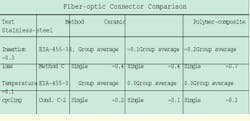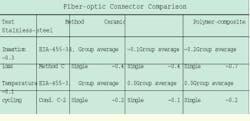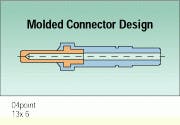"Polymer-composite connectors can now match the performance of connectors made with other materials."
Craig Kegerise and Bryan Edwards
AMP Inc.
Connections are critical components in fiber-optic cable networks. Without high-quality connectors, installers confront high insertion loss and may be faced with substandard network performance. Fortunately, material and manufacturing improvements in the last five years have significantly advanced fiber-optic connector capabilities. We now have more choices, even if there is seemingly less distinction between them.
The most revolutionary changes in connector technology have occurred in polymer composites. While conventional wisdom views this material as the lower-performance, low-cost sibling of ceramic, polymer-composite connectors have caught up with other materials and now meet tia/eia-568a specifications. And polymer-composite connectors supply these improved properties while maintaining their original benefits.
Matching other materials
Every fiber-optic connector uses one of three ferrule materials: polymer composite, ceramic, or stainless steel. While assembly methods are the same for all three materials, performance and price have traditionally varied. Recent connector testing, however, has shown that polymer composites can match ceramic and stainless steel in fiber-optic connection capability.
This testing indicated that the average insertion loss of polymer-composite and ceramic connectors differs by only 0.1 decibel. This difference does not affect network performance in any application. With an average insertion loss of 0.2 dB, polymer-composite connectors exceed the tia/eia-568a connector specification of 0.75 dB and essentially match the performance of ceramic.
In temperature-cycling and cable- retention tests, polymer-composite and ceramic connectors are also about equal. Both types of connectors, on average, do not change optical transmittance when subjected to temperature cycles ranging from -40o to +85oC. Likewise, cable- retention tests show no transmittance change after testing for both connector materials.
When compared to stainless-steel devices, polymer-composite connectors outperformed them in temperature cycling and insertion loss in these tests. Test-group averages also show identical cable-retention performance for both materials.
Perfecting performance
What changes have led to this equalization in performance of ferrule materials? Early polymer-composite connectors suffered from performance complications. Due to manufacturing inconsistencies, connector performances varied. Sometimes a polymer-composite connector afforded perfect alignment, but at other times it would cause unacceptable insertion loss. These variations stemmed in part from the procedure of drilling the fiber hole in the ferrules. Drilling, even with lasers, could not consistently meet the exacting requirements of fiber-optic systems. Fiber holes had to be, and must still be, perfectly sized, centered, and rounded to minimize loss.
Additionally, adhesives and ultrasonic welds used to join the ferrule and connector body caused variations in connector-body dimensional characteristics. Temperature cycling also caused higher insertion loss in these early polymer-composite connectors than was the case with ceramic connectors. Also, polymer materials were not generally as durable as ceramic and stainless steel.
Today, properly designed polymer-composite connectors use new materials and manufacturing processes that eliminate these problems. For example, a precise molding technique has been developed that joins the ferrule and connector body without adhesives or ultrasonic welds. The ferrule of this connector is encapsulated in a molded body that retains alignment through design.
The body material forms over the retention features on the ferrule and provides an inherent seal. The strength of this seal protects the connector from delamination and alignment inconsistencies. This improves performance during thermal cycling and makes the connector more rigid. To further improve alignment, it is possible to mold a precise hole into the ferrule instead of drilling.
Engineers have also been able to reformulate polymer composition to increase durability and decrease the effects of temperature cycling. Properly designed polymer-composite connectors now retain high performance through 500 cycles, which meets tia/eia-568a specifications and all practical application requirements. The new formulation also maintains optical transmittance when subjected to temperature cycles ranging from -40o to +85oC, providing reliable connections across a variety of environmental conditions.
Polymer-composite connectors can now match the performance of connectors made with other materials. As a result, installers and their customers have a wider variety of high-quality connectors from which to choose.
A molded connector design makes proper alignment of the optical fiber less dependent upon the material and manufacturing of the ferrule, by engineering precision into the connector design itself.
Craig B. Kegerise, registered communications distribution designer (rcdd), is global product manager and Bryan T. Edwards is project manager, both at the Optical Connectors & Assemblies Div. of AMP Inc. (Harrisburg, PA).


